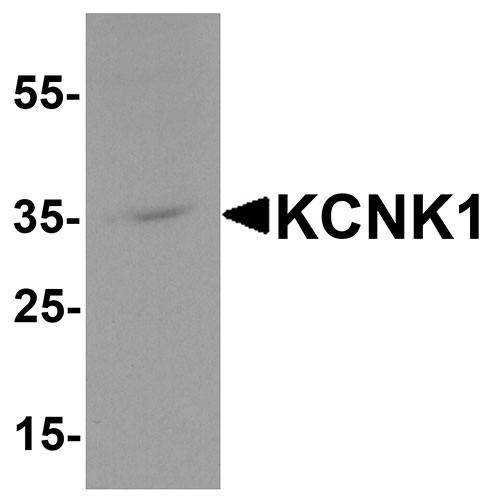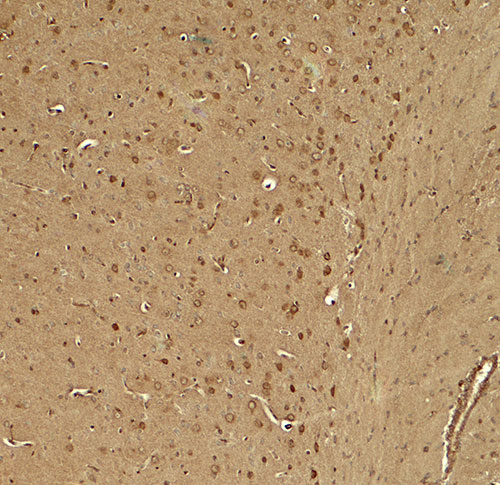KCNK1 Antibody
- SPECIFICATION
- CITATIONS
- PROTOCOLS
- BACKGROUND

Application
| WB, IHC-P, IF, E |
|---|---|
| Primary Accession | O00180 |
| Other Accession | NP_002236, 4504847 |
| Reactivity | Human, Mouse, Rat |
| Host | Rabbit |
| Clonality | Polyclonal |
| Isotype | IgG |
| Calculated MW | Predicted: 37 kDa Observed: 35 kDa |
| Application Notes | KCNK1 antibody can be used for detection of KCNK1 by Western blot at 1 - 2 µg/ml. Antibody can also be used for immunohistochemistry starting at 5 µg/mL. For immunofluorescence start at 20 µg/mL. |
| Gene ID | 3775 |
|---|---|
| Target/Specificity | KCNK1; KCNK1 antibody is human, mouse and rat reactive. KCNK1 antibody is predicted to not cross-react with other KCNK proteins. |
| Reconstitution & Storage | KCNK1 antibody can be stored at 4℃ for three months and -20℃, stable for up to one year. |
| Precautions | KCNK1 Antibody is for research use only and not for use in diagnostic or therapeutic procedures. |
| Name | KCNK1 |
|---|---|
| Synonyms | HOHO1 {ECO:0000303|PubMed:9462864}, KCNO |
| Function | Ion channel that contributes to passive transmembrane potassium transport and to the regulation of the resting membrane potential in brain astrocytes, but also in kidney and in other tissues (PubMed:15820677, PubMed:21653227). Forms dimeric channels through which potassium ions pass in accordance with their electrochemical gradient. The channel is selective for K(+) ions at physiological potassium concentrations and at neutral pH, but becomes permeable to Na(+) at subphysiological K(+) levels and upon acidification of the extracellular medium (PubMed:21653227, PubMed:22431633). The homodimer has very low potassium channel activity, when expressed in heterologous systems, and can function as weakly inward rectifying potassium channel (PubMed:8605869, PubMed:8978667, PubMed:15820677, PubMed:21653227, PubMed:22431633, PubMed:23169818, PubMed:25001086). Channel activity is modulated by activation of serotonin receptors (By similarity). Heterodimeric channels containing KCNK1 and KCNK2 have much higher activity, and may represent the predominant form in astrocytes (By similarity). Heterodimeric channels containing KCNK1 and KCNK3 or KCNK9 have much higher activity (PubMed:23169818). Heterodimeric channels formed by KCNK1 and KCNK9 may contribute to halothane-sensitive currents (PubMed:23169818). Mediates outward rectifying potassium currents in dentate gyrus granule cells and contributes to the regulation of their resting membrane potential (By similarity). Contributes to the regulation of action potential firing in dentate gyrus granule cells and down-regulates their intrinsic excitability (By similarity). In astrocytes, the heterodimer formed by KCNK1 and KCNK2 is required for rapid glutamate release in response to activation of G- protein coupled receptors, such as F2R and CNR1 (By similarity). Required for normal ion and water transport in the kidney (By similarity). Contributes to the regulation of the resting membrane potential of pancreatic beta cells (By similarity). The low channel activity of homodimeric KCNK1 may be due to sumoylation (PubMed:15820677, PubMed:20498050, PubMed:23169818). The low channel activity may be due to rapid internalization from the cell membrane and retention in recycling endosomes (PubMed:19959478). |
| Cellular Location | Cell membrane; Multi-pass membrane protein {ECO:0000269|PubMed:22282804, ECO:0000269|PubMed:8978667, ECO:0000305} Recycling endosome. Synaptic cell membrane {ECO:0000250|UniProtKB:Q9Z2T2}. Cytoplasmic vesicle {ECO:0000250|UniProtKB:O08581}. Perikaryon {ECO:0000250|UniProtKB:O08581}. Cell projection, dendrite {ECO:0000250|UniProtKB:O08581}. Cell projection {ECO:0000250|UniProtKB:O08581}. Apical cell membrane; Multi-pass membrane protein. Note=The heterodimer with KCNK2 is detected at the astrocyte cell membrane. Not detected at the astrocyte cell membrane when KCNK2 is absent. Detected on neuronal cell bodies, and to a lesser degree on neuronal cell projections. Detected on hippocampus dentate gyrus granule cell bodies and to a lesser degree on proximal dendrites Detected at the apical cell membrane in stria vascularis in the cochlea. Detected at the apical cell membrane of vestibular dark cells situated between the crista and the utricle in the inner ear. Detected at the apical cell membrane in kidney proximal tubule segment S1 and in subapical compartments in segments S1, S2 and S3. Predominantly in cytoplasmic structures in kidney distal convoluted tubules and collecting ducts (By similarity). Detected at the apical cell membrane of bronchial epithelial cells (PubMed:21964404) {ECO:0000250|UniProtKB:O08581, ECO:0000250|UniProtKB:Q9Z2T2, ECO:0000269|PubMed:21964404} |
| Tissue Location | Detected in bronchial epithelial cells (PubMed:21964404). Detected in heart left atrium and left ventricle (PubMed:17478540). Detected in cardiac myocytes (at protein level) (PubMed:21653227). Widely expressed with high levels in heart, brain and kidney, and lower levels in colon, ovary, placenta, lung and liver (PubMed:8605869, PubMed:9362344). Highly expressed in cerebellum, and detected at lower levels in amygdala, caudate nucleus, brain cortex, hippocampus, putamen, substantia nigra, thalamus, dorsal root ganglion, spinal cord, pituitary, heart, kidney, lung, placenta, pancreas, stomach, small intestine, uterus and prostate (PubMed:11165377) Detected in right and left heart ventricle and atrium, and in heart Purkinje fibers (PubMed:17478540). |

Thousands of laboratories across the world have published research that depended on the performance of antibodies from Abcepta to advance their research. Check out links to articles that cite our products in major peer-reviewed journals, organized by research category.
info@abcepta.com, and receive a free "I Love Antibodies" mug.
Provided below are standard protocols that you may find useful for product applications.
Background
The potassium channel, subfamily K, member 1 (KCNK1), is member of the superfamily of potassium channel proteins containing two pore-forming P domains (1,2). KCNK1 is a ubiquitous human weakly inward rectifying K+ channel that is widely expressed in human tissues, and particularly abundant in brain and heart (1). Both KCNK1 and the related protein KCNK2 contribute significantly to the passive conductance of hippocampal astrocytes (3).
References
Lesage F, Guillemare E, Fink M, et al. TWIK-1, a ubiquitous human weakly inward rectifying K+ channel with a novel structure. EMBO J. 1996; 15:1004-11.
Goldstein SA, Bockenhauer D, O’Kelly I, et al. Potassium leak channels and the KCNK family of two-P domain subunits. Nat. Rev. Neurosci. 2001; 2:175-84.
Zhou M, Xu G, Xie M, et al. TWIK-1 and TREK-2 are potassium channels contributing significantly to astrocyte passive conductance in rat hippocampal slides. J. Neurosci. 2009; 29:8551-64.
If you have used an Abcepta product and would like to share how it has performed, please click on the "Submit Review" button and provide the requested information. Our staff will examine and post your review and contact you if needed.
If you have any additional inquiries please email technical services at tech@abcepta.com.













 Foundational characteristics of cancer include proliferation, angiogenesis, migration, evasion of apoptosis, and cellular immortality. Find key markers for these cellular processes and antibodies to detect them.
Foundational characteristics of cancer include proliferation, angiogenesis, migration, evasion of apoptosis, and cellular immortality. Find key markers for these cellular processes and antibodies to detect them. The SUMOplot™ Analysis Program predicts and scores sumoylation sites in your protein. SUMOylation is a post-translational modification involved in various cellular processes, such as nuclear-cytosolic transport, transcriptional regulation, apoptosis, protein stability, response to stress, and progression through the cell cycle.
The SUMOplot™ Analysis Program predicts and scores sumoylation sites in your protein. SUMOylation is a post-translational modification involved in various cellular processes, such as nuclear-cytosolic transport, transcriptional regulation, apoptosis, protein stability, response to stress, and progression through the cell cycle. The Autophagy Receptor Motif Plotter predicts and scores autophagy receptor binding sites in your protein. Identifying proteins connected to this pathway is critical to understanding the role of autophagy in physiological as well as pathological processes such as development, differentiation, neurodegenerative diseases, stress, infection, and cancer.
The Autophagy Receptor Motif Plotter predicts and scores autophagy receptor binding sites in your protein. Identifying proteins connected to this pathway is critical to understanding the role of autophagy in physiological as well as pathological processes such as development, differentiation, neurodegenerative diseases, stress, infection, and cancer.




